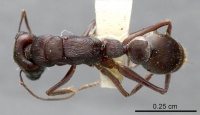Myrmecia tepperi
| Myrmecia tepperi | |
|---|---|

| |
| Scientific classification | |
| Kingdom: | Animalia |
| Phylum: | Arthropoda |
| Class: | Insecta |
| Order: | Hymenoptera |
| Family: | Formicidae |
| Subfamily: | Myrmeciinae |
| Tribe: | Myrmeciini |
| Genus: | Myrmecia |
| Species group: | pilosula |
| Species: | M. tepperi |
| Binomial name | |
| Myrmecia tepperi Emery, 1898 | |
Photo Gallery
 This Myrmecia tepperi worker was encountered on a cold night near Kalamunda, Perth, Western Australia. It was suprisingly alert and seemed to be taking shelter under a large piece of loose bark, which was strange given the time of night. It would be expected that most workers would have returned to their nest by now, but it may be that this species is nocturnal, or even noctidiurnal. Photo by Farhan Bokhari, 11 July 2009.
This Myrmecia tepperi worker was encountered on a cold night near Kalamunda, Perth, Western Australia. It was suprisingly alert and seemed to be taking shelter under a large piece of loose bark, which was strange given the time of night. It would be expected that most workers would have returned to their nest by now, but it may be that this species is nocturnal, or even noctidiurnal. Photo by Farhan Bokhari, 11 July 2009.
Identification
Heterick (2009) - Myrmecia tepperi is quite similar to Myrmecia michaelseni and Myrmecia rugosa, but can be distinguished by its reduced mandibular dentition (a characteristic of this and the Myrmecia mandibularis species-groups) and the absence of yellow pubescence from the first gastral tergite (present on the second and subsequent tergites).
Keys including this Species
Distribution
Latitudinal Distribution Pattern
Latitudinal Range: -30.16666667° to -36.91667175°.
| North Temperate |
North Subtropical |
Tropical | South Subtropical |
South Temperate |
- Source: AntMaps
Distribution based on Regional Taxon Lists
Australasian Region: Australia (type locality).
Distribution based on AntMaps
Distribution based on AntWeb specimens
Check data from AntWeb
Countries Occupied
| Number of countries occupied by this species based on AntWiki Regional Taxon Lists. In general, fewer countries occupied indicates a narrower range, while more countries indicates a more widespread species. |

|
Estimated Abundance
| Relative abundance based on number of AntMaps records per species (this species within the purple bar). Fewer records (to the left) indicates a less abundant/encountered species while more records (to the right) indicates more abundant/encountered species. |

|
Biology
Castes
Phylogeny
| Myrmecia |
| ||||||||||||||||||||||||||||||||||||||||||||||||||||||||||||||||||||||||||||||||||||||||||||||||||||||||||||||||||||||||||||||||||||||||||||||||||||||||||||||||||||||||||||||||||||||||||||||||||||||||||||||||||||||||||||||||||||||||||||||||||||||||||||||||||||||||||||||||||||||||||||||||||||||||||||||||||||||||||||||||||||||||||||||||||||||||||||||||||
Based on Mera-Rodríguez et al. (2023).
Nomenclature
The following information is derived from Barry Bolton's Online Catalogue of the Ants of the World.
- tepperi. Myrmecia tepperi Emery, 1898b: 231, fig. 1 (q.m.) AUSTRALIA (South Australia).
- Type-material: 1 syntype queen, 1 syntype male.
- Type-locality: Australia: South Australia (J.G.O. Tepper).
- Type-depository: MSNG.
- Clark, 1943: 130 (w.); Wheeler, G.C. & Wheeler, J. 1971d: 253 (l.).
- Combination in Promyrmecia: Clark, 1943: 130;
- combination in Myrmecia: Taylor & Brown, 1985: 17.
- Status as species: Emery, 1911d: 21; Clark, 1943: 130 (redescription); Clark, 1951: 172 (redescription); Taylor & Brown, 1985: 17; Taylor, 1987a: 46; Ogata, 1991a: 362; Ogata & Taylor, 1991: 1642 (in key); Bolton, 1995b: 273; Heterick, 2009: 123.
- Distribution: Australia.
Type Material
- Syntype, 2 workers, Mt. Lofty Ranges, South Australia, Australia, Harvey,R., ANIC32-017885, Australian National Insect Collection.
- Syntype, queen(s), male(s), South Australia, Australia.
Description
Karyotype
- See additional details at the Ant Chromosome Database.
 Explore: Show all Karyotype data or Search these data. See also a list of all data tables or learn how data is managed.
Explore: Show all Karyotype data or Search these data. See also a list of all data tables or learn how data is managed.
- 2n = 70 (Australia) (Browning, 1987).
References
- Emery, C. 1898b. Descrizioni di formiche nuove malesi e australiane. Note sinonimiche. Rend. Sess. R. Accad. Sci. Ist. Bologna (n.s.) 2: 231-245.
- Clark, J. 1943. A revision of the genus Promyrmecia Emery (Formicidae). Mem. Natl. Mus. Vic. 13: 83-149 (page 130, Combination in Promyrmecia)
- Clark, J. 1951. The Formicidae of Australia. 1. Subfamily Myrmeciinae: 230 pp. CSIRO, Melbourne. [(31.xii).1951.]
- Heterick, B. E. 2009. A guide to the ants of South-western Australia. Records of the Western Australian Museum, Supplement 76:1-206.
- Heterick, B.E. 2021. A guide to the ants of Western Australia. Part I: Systematics. Records of the Western Australian Museum, Supplement 86, 1-245 (doi:10.18195/issn.0313-122x.86.2021.001-245).
- Heterick, B.E. 2022. A guide to the ants of Western Australia. Part II: Distribution and biology. Records of the Western Australian Museum, supplement 86: 247-510 (doi:10.18195/issn.0313-122x.86.2022.247-510).
- Mera-Rodríguez, D., Jourdan, H., Ward, P.S., Shattuck, S., Cover, S.P., Wilson, E.O., Rabeling, C. 2023. Biogeography and evolution of social parasitism in Australian Myrmecia bulldog ants revealed by phylogenomics. Molecular Phylogenetics and Evolution 186, 107825 (doi:10.1016/j.ympev.2023.107825).
- Ogata, K. 1991a. Ants of the genus Myrmecia Fabricius: a review of the species groups and their phylogenetic relationships (Hymenoptera: Formicidae: Myrmeciinae). Syst. Entomol. 16: 353-381 (page 361, see also)
- Taylor, R. W.; Brown, D. R. 1985. Formicoidea. Zool. Cat. Aust. 2:1- 149: 1-149, 30 (page 17, Combination in Myrmecia)
- Wheeler, G. C.; Wheeler, J. 1971d. Ant larvae of the subfamily Myrmeciinae (Hymenoptera: Formicidae). Pan-Pac. Entomol. 47: 245-256 (page 253, larva described)
References based on Global Ant Biodiversity Informatics
- Taylor R. W., and D. R. Brown. 1985. Formicoidea. Zoological Catalogue of Australia 2: 1-149.
Categories:
- Pages using DynamicPageList3 parser function
- Pages using duplicate arguments in template calls
- Photo Gallery
- South subtropical
- South temperate
- ANIC specimen
- Karyotype
- Species
- Extant species
- Formicidae
- Myrmeciinae
- Myrmeciini
- Myrmecia
- Myrmecia tepperi
- Myrmeciinae species
- Myrmeciini species
- Myrmecia species
- Need Overview
- Need Body Text


